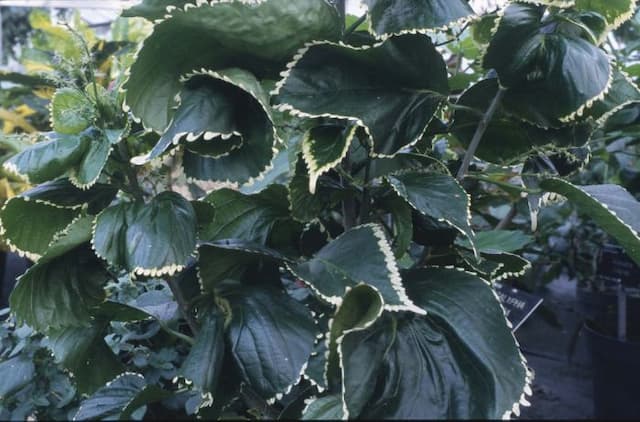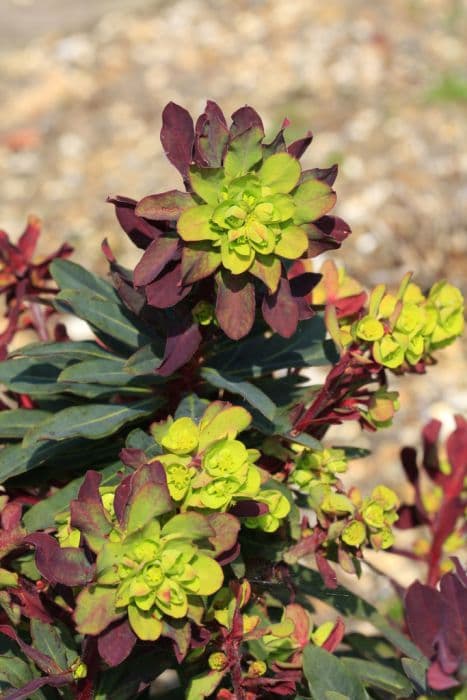Mediterranean Spurge Euphorbia characias subsp. characias 'Humpty Dumpty'

ABOUT
'Humpty Dumpty' is an ornamental plant with a distinct, eye-catching form. It features a dense, bushy habit, with foliage that is a beautiful blue-green color. The leaves themselves are narrow, elongated, and somewhat cylindrical, giving a spiky appearance overall. Throughout spring and early summer, 'Humpty Dumpty' produces striking flower heads that are arranged in an elongated, clustered shape known as an inflorescence. These flowers are typically a vibrant chartreuse-green hue and are notable for their unique, almost architectural shape, making the plant highly attractive to both gardeners and pollinators alike. The stems which hold the flower clusters are sturdy and upright, ensuring that the blooms are well-displayed above the leafy body of the plant. Overall, the plant has a sturdy, upright look with a textured finish given by the combination of its leaves and standout flowers.
About this plant
 Names
NamesFamily
Euphorbiaceae
Synonyms
Mediterranean Spurge, Albanian Spurge
Common names
Euphorbia characias subsp. wulfenii 'Humpty Dumpty'.
 Toxicity
ToxicityTo humans
The Mediterranean Spurge can be quite toxic to humans if ingested or if its sap comes into contact with skin or eyes. The plant contains a white, milky sap known as latex, which has irritant properties. If the sap contacts the skin, it can cause redness, swelling, and blistering. In the eyes, it can lead to pain, redness, and even temporary blindness. If ingested, the sap can cause severe pain in the mouth and throat, nausea, vomiting, diarrhea, and in extreme cases, more severe systemic reactions could occur. It is important to handle Mediterranean Spurge with care and to seek medical attention if there is significant exposure, especially to the eyes or if ingested.
To pets
The Mediterranean Spurge is toxic to pets and can cause a range of symptoms if ingested or if they come into contact with the plant's sap. The milky sap contains skin and mucous membrane irritants. If a pet gets the sap on its skin or fur, it can lead to irritation, redness, and swelling. Ingesting the plant can cause symptoms such as vomiting, diarrhea, drooling, and in severe cases, weakness or lethargy due to gastrointestinal distress. If the sap gets into the pet’s eyes, it can result in pain and inflammation, potentially leading to temporary blindness. If your pet has been exposed to the plant, it is advisable to consult a veterinarian as soon as possible.
 Characteristics
CharacteristicsLife cycle
Perennials
Foliage type
Evergreen
Color of leaves
Blue-green
Flower color
Yellow-green
Height
2-3 feet (60-90 cm)
Spread
2 feet (60 cm)
Plant type
Shrub
Hardiness zones
8-11
Native area
Mediterranean
Benefits
 General Benefits
General Benefits- Drought Tolerance: Mediterranean spurge is highly resistant to drought, making it ideal for xeriscaping and arid climate gardens.
- Low Maintenance: It typically requires minimal care once established, needing little to no supplementary watering or fertilizing.
- Attractive Foliage: The plant has distinctive, blue-green leaves that add a unique texture and color contrast to the garden.
- Year-Round Interest: Produces yellow-green flowers that can add visual interest to the landscape throughout the blooming season, and its foliage remains attractive year-round.
- Pest Resistance: It is generally resistant to pests and diseases, reducing the need for chemical interventions in the garden.
- Wildlife Attraction: The flowers are known to attract pollinators such as bees, which are beneficial for the garden ecosystem.
- Soil Erosion Control: The dense growth habit can help stabilize soil in sloped areas and prevent erosion.
- Architectural Plant: Mediterranean spurge has a structured form that can serve as an architectural feature in garden design.
- Versatility: Suitable for a variety of garden styles, including rock gardens, Mediterranean gardens, and modern landscapes.
 Medical Properties
Medical PropertiesThis plant is not used for medical purposes.
 Air-purifying Qualities
Air-purifying QualitiesThis plant is not specifically known for air purifying qualities.
 Other Uses
Other Uses- Euphorbia 'Humpty Dumpty' can be used as an artistic medium for outdoor sculpture gardens, as its unique structure and vivid green color provides a natural yet striking element to the landscape.
- The sap of Euphorbia 'Humpty Dumpty', although irritant to skin, has traditional uses as a natural adhesive in some cultures for mending pottery and ceramics.
- This plant can be utilized as a natural dye, with the milky sap producing a unique color when treated properly, though it is not a common practice, considering the irritant properties of the sap.
- As a teaching tool in botany classes to demonstrate the diversity of plant life forms and adaptation strategies, especially the modified stems and the plant's resilience.
- In eco-friendly landscaping, Euphorbia 'Humpty Dumpty' serves as an example of a drought-resistant plant that contributes to water conservation efforts in gardening designs.
- Euphorbia 'Humpty Dumpty' can be used in creative photography projects, its abstract form and texture giving a unique aesthetic to close-up or macro photography.
- Its ability to thrive in poor soils can be educational in soil conservation and erosion control studies, demonstrating how different plants can be utilized to stabilize soils.
- In landscape design, the plant is sometimes used for its geometric shapes which can complement modern, minimalist design aesthetics.
- Euphorbia 'Humpty Dumpty' might be used as a natural pest deterrent, with its toxic sap being unpalatable to many grazing animals and insects, although this use should be approached with caution due to the potential risks to wildlife.
- The structured growth pattern of Euphorbia 'Humpty Dumpty' can be inspirational to artists and designers, who might use its form as a basis for patterns, prints, and architectural elements.
Interesting Facts
 Feng Shui
Feng ShuiThe Mediterranean Spurge is not used in Feng Shui practice.
 Zodiac Sign Compitability
Zodiac Sign CompitabilityThe Mediterranean Spurge is not used in astrology practice.
 Plant Symbolism
Plant Symbolism- Resilience: Euphorbia plants typically symbolize resilience due to their ability to thrive in tough conditions and adapt to various climates, much like the ability of 'Humpty Dumpty' to maintain its structure in various garden settings.
- Protection: The Euphorbia family is known for its toxic sap, representing protection and defense, suggesting that Euphorbia 'Humpty Dumpty' may symbolically offer a barrier against negative forces.
- Healing: Historically, some Euphorbia species have been used in traditional medicine, so this plant could carry a symbolic meaning of healing or curing ailments.
- Persistence: The robust nature of the 'Humpty Dumpty' indicates a symbol of persistence, growing persistently throughout the seasons without demanding excessive care.
 Water
WaterFor the Spurge 'Humpty Dumpty', watering should be done cautiously to ensure the soil is moist but not waterlogged. It's typically sufficient to water this plant once every week with about 1 gallon of water, letting the soil dry out slightly between waterings. During the hotter summer months, you might need to water the Spurge slightly more often, paying attention to the plant's response to heat and adjusting accordingly. It is important not to overwater as the Spurge does not tolerate standing in moisture for extended periods.
 Light
LightThe Spurge 'Humpty Dumpty' thrives best in full sun to partial shade. An ideal spot would receive direct sunlight for several hours a day, preferably the morning sun with some afternoon shade, as prolonged exposure to hot afternoon sun might stress the plant.
 Temperature
TemperatureSpurge 'Humpty Dumpty' prefers moderate temperatures and can tolerate a range from around 40 degrees Fahrenheit minimum to about 85 degrees Fahrenheit maximum. The ideal temperature range for this plant is between 60 and 75 degrees Fahrenheit to encourage vigorous growth and flowering.
 Pruning
PruningPruning the Spurge 'Humpty Dumpty' is generally done to remove spent flowers and to maintain the plant's shape. The best time for pruning is after the plant has finished flowering, typically in late summer or fall. Cut back the flower stems to the base, and additionally, trim any wayward or damaged branches to keep the plant tidy.
 Cleaning
CleaningAs needed
 Soil
SoilThe Mediterranean Spurge 'Humpty Dumpty' thrives in well-draining soil with a mixture of loam, sand, and peat to mimic its native habitat conditions. A balanced pH range between 6.0 and 7.5 is ideal for optimal growth and flowering.
 Repotting
RepottingMediterranean Spurge 'Humpty Dumpty' should be repotted every 2-3 years or when it has outgrown its current pot, to refresh the soil and provide room for growth.
 Humidity & Misting
Humidity & MistingMediterranean Spurge 'Humpty Dumpty' prefers a dry environment with low to moderate humidity levels, similar to its Mediterranean origin.
 Suitable locations
Suitable locationsIndoor
Place in bright light, minimal water.
Outdoor
Full sun to part shade, well-drained soil.
Hardiness zone
7-10 USDA
 Life cycle
Life cycleEuphorbia characias subsp. characias 'Humpty Dumpty', commonly known as spurge, begins its life cycle as a seed, which upon germination in suitable conditions, sprouts into a seedling. The seedling stage is characterized by the growth of a small rosette of leaves as it establishes itself. As it matures, spurge enters a vegetative stage, marked by the rapid growth of foliage and stems, eventually forming a dense, bushy plant. During the reproductive stage, the plant produces distinct greenish-yellow flowers, typically in late winter to early spring, followed by the development of fruit which contains seeds for the next generation. After setting seed, the spurge may experience senescence, where parts of the plant begin to die back, particularly in regions with cold winters. With each season, the plant can rejuvenate from the rootstock or from self-sown seeds, continuing its life cycle.
 Propogation
PropogationPropogation time
Spring-Early Summer
Euphorbia characias subsp. characias 'Humpty Dumpty', commonly known as Mediterranean Spurge, is primarily propagated through seed or by taking cuttings. The most popular method of propagation for Mediterranean Spurge is by cuttings, and this process is ideally done in late spring or early summer. When taking cuttings, one should select healthy, non-flowering stems and cut them into lengths of about 3 to 6 inches (7.62 to 15.24 cm). It's crucial to allow the cut end to dry and form a callus for a few days before planting. The cuttings should then be inserted into a well-draining soil mix and kept in a warm, bright place but out of direct sunlight until they root, which typically takes a few weeks. During this time, the soil should be kept moderately moist but not waterlogged to prevent rot.



![Spurge [Blackbird]](/_next/image?url=https%3A%2F%2Fplants-admin.emdemapps.com%2Fimages%2Fplants%2F%2Fimages%2F604b535f37783.png&w=640&q=75)





